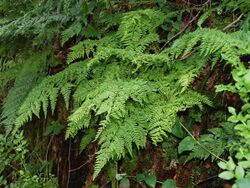Biology:Dryopteris aemula
| Hay-scented buckler-fern | |
|---|---|

| |
| Dryopteris aemula in Galloway, Southern Scotland | |
| Scientific classification | |
| Kingdom: | Plantae |
| Clade: | Tracheophytes |
| Division: | Polypodiophyta |
| Class: | Polypodiopsida |
| Order: | Polypodiales |
| Suborder: | Polypodiineae |
| Family: | Dryopteridaceae |
| Genus: | Dryopteris |
| Species: | D. aemula
|
| Binomial name | |
| Dryopteris aemula (Aiton) Kuntze
| |
Dryopteris aemula, the hay-scented buckler-fern[1] or hay-scented fern, is a species of perennial leptosporangiate fern.
Description
Dryopteris aemula grows as a crown of fronds arising from a short ascending rhizome.
The rachis is dark purple-brown with red-brown lanceolate scales. Leaves are tri-pinnate, triangular-ovate or triangular-lanceolate, 15–60 cm (5.9–23.6 in) long, often arching, semi-evergreen and pale yellow-green. Scattered small sessile glands grow on the underside or both surfaces of the fronds. Pinnae are slightly concave giving the frond a characteristic crisped appearance. The plant is hay-scented.[2]
Sori or spore-producing organs occur in a row down each side of the midrib. The indusium of the sorus is irregularly toothed and edged with sessile glands.
The plant does not reproduce vegetatively and relies upon spores to generate new individuals.[3]
Taxonomy
Distribution
Dryopteris aemula is confined to the atlantic coastal areas of western Europe and Macaronesia. D. aemula is highly oceanic in its distribution occurring mostly in the Köppen climate type Cfb (oceanic climates). Even within Great Britain, it is restricted to western districts and has just a few outlying eastern localities such as The Weald.
D. aemula reaches the northern limit of its distribution in Britain.
20% of the world population of D. aemula is in the United Kingdom.[4]
Ecology and conservation
A fern of shady, often rocky, woodlands, usually on acidic soils.
In Britain, it is generally found in NVC woodland community W17.
References
- ↑ (xls) BSBI List 2007, Botanical Society of Britain and Ireland, https://bsbi.org/download/3542/, retrieved 2014-10-17
- ↑ Murthy, Hosakatte Niranjana (2023-06-20) (in en). Bioactive Compounds in Bryophytes and Pteridophytes. Springer Nature. ISBN 978-3-031-23243-5. https://books.google.com/books?id=A37GEAAAQBAJ&dq=Dryopteris+aemula+morphology+uses&pg=PA554.
- ↑ (in en) Micron. Pergamon Press. 1969. https://books.google.com/books?id=jNsgAAAAIAAJ&q=Dryopteris+aemula+morphology+uses.
- ↑ "Kent Biodiversity Action Plan". 1997. https://www.medway.gov.uk/download/downloads/id/279/kent_biodiversity_action_plan.pdf.
External links
- National Biodiversity Network's Gateway : grid map for Dryopteris aemula''
- Global Biodiversity Information Facility (GBIF) Data Portal: Dryopteris aemula
- Ecological Flora of the British Isles : Dryopteris aemula
Further reading
- Clapham A. R., Tutin, T. G., Moore D. M. (1990). Flora of the British Isles. 3rd Ed. Cambridge University Press. Cambridge.
- Page, C.N. (1997). The ferns of Britain and Ireland. 2nd Ed. Cambridge University Press. Cambridge.
- Wardlaw, A.C and Leonard, A (2005) (editors). New Atlas of Ferns & Allied Plants of Britain & Ireland. British Pteridological Society Special Publications no.8.
Wikidata ☰ Q1872846 entry
 |

